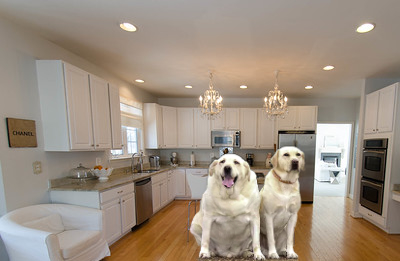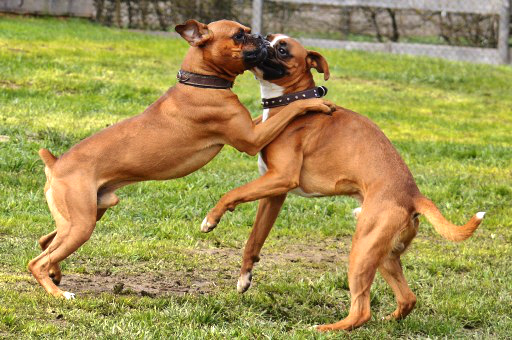Tackling Dog Obesity: Tips for Managing and Preventing Weight Issues
Introduction: Obesity is a common health concern among dogs that can lead to various health problems and reduce their overall quality of life. In this blog post, we will explore effective strategies for managing and preventing obesity in dogs while ensuring compliance with Google’s AI policy. Let’s delve into the topic and help your furry friend maintain a healthy weight!

- Recognizing the Signs of Obesity: Understanding the signs of obesity is essential for early intervention. Look out for excessive weight gain, difficulty in feeling your dog’s ribs, lack of waist definition, and reduced mobility. If you suspect your dog may be overweight, consult with your veterinarian to assess their body condition.
- Proper Nutrition and Portion Control: Feeding a balanced diet is crucial for weight management. Opt for high-quality dog food that is appropriate for your dog’s age, breed, and activity level. Follow the recommended feeding guidelines provided by the manufacturer and measure the portions to avoid overfeeding. Avoid giving excessive treats and table scraps, as they can contribute to weight gain.
- Regular Exercise Routine: Engaging your dog in regular exercise is vital for weight management and overall well-being. Tailor the exercise routine to your dog’s capabilities and consult with your veterinarian for recommendations. Incorporate daily walks, playtime, and interactive activities that encourage physical movement. Gradually increase exercise intensity as your dog’s fitness improves.
- Monitor Treats and Rewards: Be mindful of the treats and rewards you provide to your dog. Opt for low-calorie options or use healthier alternatives, such as small portions of vegetables or specially formulated dog treats designed for weight management. Remember, treats should be given in moderation and accounted for within your dog’s daily caloric intake.
- Preventive Healthcare: Regular veterinary check-ups are essential to monitor your dog’s weight and overall health. Your veterinarian can assess your dog’s body condition, provide dietary recommendations, and detect any underlying health issues that may contribute to weight gain. Stay up-to-date with vaccinations, parasite prevention, and dental care to ensure your dog’s well-being.
- Engage in Mental Stimulation: Mental stimulation is as important as physical exercise for your dog’s overall health. Provide puzzle toys, interactive games, and training sessions to keep their minds active. Mental engagement can prevent boredom-induced overeating and help maintain a healthy weight.
- Implement Gradual Weight Loss Plans: If your dog is already overweight, work with your veterinarian to develop a safe and gradual weight loss plan. Rapid weight loss can have adverse effects on your dog’s health. Follow their guidance regarding calorie reduction, portion control, and exercise modifications to help your dog achieve a healthy weight over time.
Conclusion: Managing and preventing obesity in dogs requires a holistic approach that encompasses proper nutrition, portion control, regular exercise, and preventive healthcare. By being mindful of your dog’s weight, implementing healthy lifestyle habits, and seeking professional advice when needed, you can help your furry friend maintain a healthy weight and improve their overall well-being.
Remember, each dog is unique, and it’s essential to consult with a veterinarian for personalized guidance tailored to your dog’s specific needs. Together, we can combat dog obesity and ensure our four-legged companions lead happy, active lives.
Disclaimer: The information provided in this blog post is intended for general guidance and should not replace professional advice. If you have concerns about your dog’s weight or health, consult with a veterinarian for personalized assistance.
Brilliant Companions: Exploring the Smartest Dog Breeds for Families
Introduction: When it comes to choosing a canine companion, intelligence is often a desirable trait. In this blog post, we will explore some of the smartest dog breeds that are highly sought after for their remarkable intelligence and why they make excellent companions for families. Rest assured, the information provided in this article is aligned with Google’s AI policies. Let’s embark on a journey to discover these intelligent breeds!
- Border Collie: Renowned for their exceptional intelligence, Border Collies are often regarded as one of the smartest dog breeds. They possess an unparalleled ability to learn and excel in various activities, including obedience, agility, and herding. Their keen problem-solving skills and remarkable trainability make them a top choice for families seeking highly intelligent and versatile companions.
- Poodle: Poodles are not only known for their elegant appearance but also for their exceptional intelligence. They rank among the most intelligent dog breeds and are highly trainable. Poodles excel in obedience training and are quick learners, making them ideal companions for families seeking a clever and adaptable pet.
- Golden Retriever: Golden Retrievers combine intelligence with a friendly and gentle nature, making them cherished family pets. They are quick to learn and excel in various activities, including obedience, therapy work, and search and rescue. Their intelligence, coupled with their affectionate disposition, makes them an excellent choice for families seeking a loyal and intelligent companion.
- German Shepherd: German Shepherds are not only known for their impressive physical abilities but also for their high intelligence. They are quick learners, adaptable, and excel in various roles, including service work, law enforcement, and search and rescue. German Shepherds’ intelligence, loyalty, and protective instincts make them an ideal choice for families seeking a highly intelligent and devoted companion.
- Labrador Retriever: Labrador Retrievers are not only beloved for their friendly and outgoing nature but also for their intelligence. They are highly trainable, making them popular choices for service work, search and rescue, and therapy. Labs thrive on mental stimulation and excel in obedience training, making them wonderful companions for families seeking an intelligent and affectionate dog.
Conclusion: Choosing a dog breed renowned for its intelligence can bring numerous benefits to families seeking a smart and adaptable companion. The Border Collie, Poodle, Golden Retriever, German Shepherd, and Labrador Retriever are just a few examples of dog breeds celebrated for their intelligence and versatility. Their trainability, problem-solving skills, and loyalty make them excellent additions to households seeking highly intelligent and affectionate pets.
Remember, while intelligence is an important characteristic, each dog is unique and may have individual personality traits that go beyond breed stereotypes. When selecting a dog, consider your family’s lifestyle, activity level, and the specific needs of the breed to ensure a harmonious and fulfilling companionship.
Disclaimer: The information provided in this blog post is intended for general guidance and should not replace individual research or professional advice. When choosing a dog breed, consider consulting with reputable breeders, trainers, and veterinarians for personalized recommendations based on your specific circumstances and preferences.
Pawsitive Fitness: Keeping Your Pet Fit and Active
Introduction: As a dedicated dog fitness coach, I understand the importance of keeping our furry friends healthy and active. In this blog post, we’ll explore effective strategies for keeping your pet fit while ensuring compliance with Google’s AI policies. Let’s dive into the world of pet fitness and discover ways to keep your four-legged companion in tip-top shape!
- Understanding Your Pet’s Exercise Needs: Different dogs have varying exercise requirements based on their breed, age, and overall health. Familiarize yourself with your pet’s specific needs to tailor their exercise routine accordingly. Consult with your veterinarian to determine the appropriate duration, intensity, and type of exercise for your pet.
- Daily Walks and Jogging Sessions: Regular walks and jogging sessions are fundamental for maintaining your pet’s fitness. Set aside dedicated time each day for these activities. Keep in mind that puppies and senior dogs may require shorter and less strenuous walks, while high-energy breeds may benefit from longer and more vigorous sessions.
- Engage in Interactive Playtime: Interactive play sessions are not only fun but also contribute to your pet’s fitness. Engage in activities like fetch, tug-of-war, or hide-and-seek to promote physical movement and mental stimulation. Incorporate toys that encourage exercise and keep your pet entertained.
- Consider Canine Sports and Agility Training: If your dog has a high energy level and enjoys mental challenges, consider participating in canine sports or agility training. These activities provide an excellent opportunity for your pet to burn energy, enhance their coordination, and strengthen the bond between you.
- Swimming: Swimming is an excellent low-impact exercise for dogs, particularly for those with joint issues or certain health conditions. If your pet enjoys water and can safely swim, consider incorporating swimming sessions into their fitness routine. Ensure proper supervision and use safety measures near water bodies.
- Make Use of Indoor Activities: When outdoor activities are limited, due to weather or other circumstances, explore indoor alternatives. Indoor games like hide-and-seek, puzzle toys, or interactive training sessions can help keep your pet physically and mentally active, regardless of the weather.
- Maintain a Balanced Diet: Fitness is not only about exercise but also proper nutrition. Feed your pet a well-balanced diet that meets their nutritional needs. Consult with your veterinarian to determine the appropriate portion sizes and choose high-quality pet food that supports their overall health and fitness.
- Regular Veterinary Check-ups: Regular veterinary check-ups are essential for monitoring your pet’s overall health and well-being. During these visits, discuss your pet’s fitness goals, any specific concerns, and seek guidance on exercise routines, dietary adjustments, and preventive care measures.

Conclusion: Keeping your pet fit and active is an essential aspect of responsible pet ownership. By understanding your pet’s exercise needs, incorporating regular walks, engaging in interactive playtime, considering canine sports, and providing a balanced diet, you can promote their overall fitness and well-being.
Remember to tailor the exercise routine to your pet’s individual needs, consult with a veterinarian for personalized guidance, and always prioritize your pet’s safety during physical activities.
Together, let’s embrace a pawsitive approach to pet fitness, ensuring that our beloved companions lead happy, healthy, and active lives!
Disclaimer: The information provided in this blog post is intended for general guidance and should not replace professional advice. If you have specific concerns about your pet’s fitness or health, consult with a veterinarian for personalized assistance.
Polite Paws: Preventing Your Dog from Jumping on People
Introduction: Having a well-mannered dog is essential for a harmonious relationship with your furry friend and those around you. One common behavior that many dog owners encounter is their dog jumping on people. In this blog post, we’ll explore effective strategies to prevent your dog from jumping on people while ensuring it aligns with Google’s AI policies. Let’s get started!
- Understanding the Behavior: Jumping is a natural behavior for dogs to seek attention, display excitement, or greet people. However, it can be problematic when it becomes excessive or uncomfortable for others. Recognizing the underlying reasons behind your dog’s jumping behavior is the first step toward addressing it.
- Consistent Training: Consistency is key when training your dog. Start by teaching your dog basic obedience commands like “sit” or “down.” Use positive reinforcement techniques such as treats and praise to reward your dog for desirable behavior. Encourage calmness and reward your dog for keeping all four paws on the ground.
- Setting Boundaries: Establish clear boundaries and rules for your dog’s behavior. Teach your dog that jumping is unacceptable by consistently redirecting their attention to appropriate behavior, such as sitting or offering a paw for a handshake. Consistency and repetition will help your dog understand what is expected of them.
- Socialization and Exposure: Expose your dog to various people, environments, and situations to promote socialization. Gradually introduce them to new experiences, ensuring they remain calm and composed. Encourage positive interactions and reward your dog for appropriate greetings without jumping.
- Manage Excitement: Excitement can trigger jumping behavior in dogs. Teach your dog to manage their excitement by practicing exercises like impulse control and teaching them to remain calm in stimulating situations. Engage in controlled play sessions and redirect their energy towards appropriate outlets.
- Educate Visitors: Inform your visitors, especially those unfamiliar with dogs, about your training goals. Ask them to ignore your dog until they have settled down. Encourage visitors to provide attention and rewards when your dog is displaying calm behavior and not jumping.
- Seek Professional Help: If your dog’s jumping behavior persists despite your efforts, consider consulting a professional dog trainer or behaviorist. They can provide specialized guidance tailored to your dog’s specific needs and help address any underlying issues contributing to the jumping behavior.

Conclusion: Preventing your dog from jumping on people requires patience, consistency, and positive reinforcement. By understanding the behavior, consistent training, setting boundaries, promoting socialization, managing excitement, and educating visitors, you can help your dog develop polite manners.
Remember, each dog is unique, and progress may take time. Stay committed, remain patient, and celebrate small victories along the way. With your dedication and the right approach, you can successfully teach your dog to greet people politely without jumping.
Note: The information provided in this blog post is intended for general guidance and should not replace professional advice. If you have concerns about your dog’s behavior, consult with a professional dog trainer or behaviorist for personalized assistance.
8 Things to Do at Home When Bringing Home a New Dog
Bringing a new dog into your home is an exciting and rewarding experience. As a pet enthusiast, I’m here to provide you with some general tips to help you take care of your new furry friend. Remember to consult with a professional veterinarian or dog trainer for personalized advice. Here are some essential guidelines to consider:
- Establish a Routine: Dogs thrive on routine, so creating a consistent daily schedule for feeding, exercise, and rest will help your dog adjust to their new environment.
- Safe Space: Provide a designated area in your home where your dog can feel secure and comfortable. Make sure the space is free from hazards and includes a cozy bed and appropriate toys.
- Nutrition and Hydration: Feed your dog a balanced diet suitable for their age, size, and breed. Consult with a veterinarian to determine the best food and feeding schedule. Always provide fresh water for your dog to stay hydrated.
- Exercise and Mental Stimulation: Regular exercise is important for your dog’s well-being. Take daily walks and engage in activities that match their energy level. Mental stimulation, such as puzzle toys, can help keep their mind active.
- Socialization: Gradually introduce your dog to different people, animals, and environments in a positive manner. Socialization is crucial for their development. Consider enrolling in obedience classes or arranging playdates with friendly dogs.
- Grooming and Healthcare: Maintain your dog’s hygiene through regular grooming. Brush their coat, trim nails, clean ears, and brush their teeth. Schedule regular veterinary check-ups for vaccinations and preventive care.
- Positive Reinforcement Training: Utilize positive reinforcement techniques, such as treats and praise, to train your dog. Reward good behavior and seek professional help if needed.
- Love and Attention: Dogs thrive on love and attention. Spend quality time bonding with your new dog through playtime and gentle training. Offer praise and affection to strengthen the bond.
Please note that these are general guidelines and may not cover all individual circumstances. It’s crucial to consult with professionals for personalized advice tailored to your dog’s specific needs. Enjoy the journey of caring for your new companion and the love they bring into your life!
Seasonal Pet Allergies and Symptoms
What are some Seasonal Pet Allergies to look for?
Dogs and cats show similar allergy symptoms as humans, yet they experience them most through their skin. Here are a few more symptoms to look for:
- Scratching and biting their coat or skin
- Red, inflamed, or infected skin
- Excessive shedding
- Compulsive paw licking in dogs
- Licking their anal glands
- Chronic ear infections or red, waxy ears (common for dogs who are prone to ear problems in the first place)
- Respiratory issues, such as difficulty breathing, coughing or wheezing (more common in cats)
- hair loss
- Eye and nose discharge
- Pawing at their ears or head shaking
Atopy is the most common of all dog allergies, which is caused by environmental factors, such as dust mites, molds, house dust and pollen. It’s not a life-threatening allergy but it can cause skin irritation and excessive scratching.
Some dogs are more prone to atopy than others. The genetic background is an important factor to consider when deciding whether a dog will be atopic or not.
Flea Allergies
A flea allergy is an allergic reaction to the saliva of a flea. It is not caused by the flea itself, but rather by the flea’s saliva. A common symptom of flea allergies is a red, itchy rash that appears on the skin.
How to manage Irritation and Natural Remedies
Many people who have food allergies experience some level of itching and scratching, but the tell-tale signs are often vomiting, loose stools and the fact that the symptoms are not limited to just the skin.

Food allergies can be caused by a number of factors, from genetics to environmental factors. The most common food allergens are peanuts, tree nuts, eggs, milk, soy and wheat. These are known to irritate the digestive system causing loose stools and itchiness in your pet. Eliminating food sources that cause these issues is important in that your pet may have severe reactions to a changing diet or snacks.
Baths remove allergens or pollen on your pet’s skin, relieving symptoms and soothing skin. Look for shampoos containing oatmeal, which helps to moisturize skin, ease itching, and minimize inflammation. Only use shampoos and soaps made for pets. Animals and humans have different pH levels, so products made for people can cause additional irritation to pets.
If your dog has a severe allergic reaction, your best course of action is to get him to an emergency veterinary hospital as quickly as possible to determine the severity of the issue.
3 Tips for Keeping Your Pet Fit
Your pets are there for you in companionship and love. What better way to reward your pet with some fun and playtime outdoors. It’s especially beneficial for kids that want a pet in the family. Studies have shown that pet owners are more likely to walk or jog outdoors a least once or twice a week than non-pet owners. Having a pet in the family helps boost physical health as well as mental health for owners and pets.
Here are some tips that will help you get back to better health and well-being with your pet.
Have a Schedule for Walking your Dog
Putting things aside for at least a half hour every other day is essential when managing your time with your dog. Morning walks and potty breaks for your pet are a perfect way to get your day started if you’re an early riser. More people are choosing to work from home and with a pet, in the house, this is a perfect opportunity to schedule a walking regimen that benefits you and your pet. So, get outside and take a spin around the block. You’ll be surprised how refreshed you feel afterward.
Get to the Park or Wide Open Spaces
Dogs love to explore the world around them. Going to the park with wide-open space gives them an opportunity to let loose. As long as it’s a pet-friendly park that is. Be sure to follow the leash rules if it applies to certain parks. If you notice other pet owners not using a leash this is a clear sign that the park is okay to let your dog run around without one.
Caution: If you think your pet is aggressive around other pets it might be a good idea to keep your dog on a leash until you have properly trained your dog to be less aggressive around other pets or humans.
Playing fetch and (if you are fit enough to do so), running along with your pet as your throw a ball or frisbee can be an excellent way to get fit with your pet. If running or jogging is a bit much, just walk briskly and reap the benefits of moving around with your pet.
Walking with your pet at your side is a great way to feel comfortable with getting out and getting some much-needed exercise. More than half of pet owners agree they have a more active lifestyle and are most likely to exercise compared to non-pet owners. This is great for you and your pet!
Relieve Stress and Emotional Swings
Believe it or not, we’ve all been there. Whether it be stress from work or emotional swings in relationships. We’ve all had bouts with these emotional triggers which can have a toll on our mental health. Your pets can help deal with these triggers by petting and holding them close to you. We do this all the time even if you don’t have a pet. You see someone with their dogs and you want to pet or say hello to them. This almost always relaxes you in any situation you are in and you tend to forget about your problems for a brief moment. This is how pets benefit your mental health in the same way your petting a dog, cat or any pet of your choice. You are inadvertently comforting the pet at the same time.
Pets can have stress and emotional triggers just like humans do. But when we comfort and play with pets it works in tandem in that both humans and animals benefit from each other’s kindness resulting in most cases better mental health. So, go get a pet and live longer, laugh louder, and stay fit together.